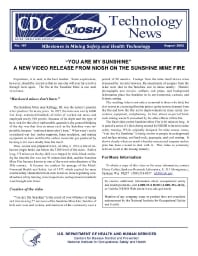Mining Publication: Technology News 497 - "You Are My Sunshine": A New Video Release From NIOSH on the Sunshine Mine Fire
Original creation date: August 2002
Authors: National Institute for Occupational Safety and Health
NIOSHTIC2 Number: 20024218
U.S. Department of Health and Human Services, Public Health Service, Centers for Disease Control and Prevention, National Institute for Occupational Safety and Health, Technology News 497, 2002 Aug; :1-2
The Sunshine Mine near Kellogg, ID, was the nation's premier silver producer for many years. In 1972, the mine was nearly 6,000 feet deep, contained hundreds of miles of worked-out areas, and employed nearly 500 people. Because of its depth and the type of host rock for the silver (unburnable quartzite), the general thinking of the day was that fires in mines such as the Sunshine were impossible, because "hard-rock mines don't burn." What wasn't really considered was that timber supports, foam insulation, and mining equipment do burn and that the carbon monoxide gas produced by burning is far more deadly than fire itself.
Thus, no one was prepared when, on May 2, 1972, a fire of unknown origin broke out below the 3100 level of the mine. Before long, 173 miners on the day shift were trapped by thick, black smoke. By the time the fire was out, 91 miners had died, and the Sunshine Mine Fire became known as one of the worst mine disasters of the 20th century. It became the catalyst for passage of the Metal/Nonmetal Health and Safety Act of 1977, which applied the same federal safety standards to hard-rock mines as those regulating coal. Mandated safety training, mine inspections, and equipment standards were brought into force.

NIOSHTIC2 Number: 20024218
U.S. Department of Health and Human Services, Public Health Service, Centers for Disease Control and Prevention, National Institute for Occupational Safety and Health, Technology News 497, 2002 Aug; :1-2
- Behavioral and Organizational Dimensions of Underground Mine Fires
- The Brookwood Disaster and Electrical Requirements for Hazardous (Classified) Locations
- The Emergency Communication Triangle
- Emergency Escape and Refuge Alternatives
- Multiple Type Discriminating Mine Fire Sensors
- Refuge Alternatives in Underground Coal Mines
- Smoke, Carbon Monoxide, and Hydrogen Chloride Production from the Pyrolysis of Conveyor Belting and Brattice Cloth
- Technology News 507 - NIOSH Safety Talk: The Emergency Communication Triangle
- Technology News 549 - MFIRE 3.0 - NIOSH Brings MFIRE into 21st Century
- Underground Coal Mining Disasters and Fatalities: United States, 1900-2006
- You Are My Sunshine